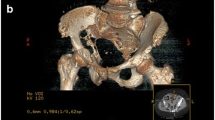Abstract
Extramedullary multiple myeloma can develop in patients with multiple myeloma, at the time of relapse, especially in those treated with allogenic bone marrow transplant. PET/MR imaging provides the ability for the detection of osseous multiple myeloma and extramedullary lesions in a single examination. It can also be helpful in monitoring response to therapy and predicting clinical outcome based on changes in metabolic activity.
Access provided by CONRICYT-eBooks. Download chapter PDF
Similar content being viewed by others
Keywords
History
A 41-year-old male with relapsed IgG kappa multiple myeloma, initially diagnosed 2 years prior, presents with mid-back pain (Fig. 15.1).
Diagnosis
Extramedullary multiple myeloma
Findings
-
Large prevertebral mass at the level of the aortic arch, which is homogenously isointense on T1-weighted image and heterogeneously hyperintense on T2.
-
Mass demonstrates moderate FDG activity compatible with malignancy (arrowheads). Mild FDG activity also noted in the adjacent vertebral body due to benign bone marrow stimulation from chemotherapy.
-
Mass pushes against the trachea (asterisks) and displaces the esophagus (thin arrow).
Discussion
Advances in the diagnosis, staging and treatment of multiple myeloma have increased the overall survival of patients inflicted with this disease to over 10 years from the time of initial diagnosis. This has contributed to an increase in the imaging diagnosis of extramedullary multiple myeloma that can develop at the time of relapse, especially in those patients treated with allogenic bone marrow transplant. There are two mechanisms in the development of extramedullary myeloma. The most common is through contiguous extension of osseous myelomatous masses in the spine which usually presents as large paraspinal or epidural masses. The second mechanism is through hematogenous spread of myeloma clone cells that have escaped the bone marrow and has disseminates to the skin, viscera, lymph nodes, upper airways, and brain.
MRI plays an important role in the management of extramedullary multiple myeloma as it helps in the initial diagnosis by clarifying ambiguous findings on other modalities, monitors disease activity, assesses response to treatment, and evaluates for potential complications. Extramedullary myeloma that is contiguous with the bone typically presents as large masses that are homogenous and hypo- to isointense compared to the skeletal muscle on T1-weighted images. It is hyperintense on T2-weighted images and enhances after gadolinium contrast administration. Some extramedullary myelomatous lesions that are not contiguous with bone can be hypointense on T2-weighted images, which may be explained by a biological similarity of these lesions to lymphoma. The most commonly encountered complications of extramedullary multiple myeloma are spinal cord compression from epidural myelomatous masses and vertebral compression fractures which can be thoroughly evaluated with MRI.
Extramedullary myeloma is metabolically active. The advent of whole-body PET/MR imaging provides the ability for the detection of osseous multiple myeloma and extramedullary lesions in a single examination. FDG PET has been shown to be helpful in monitoring response to therapy and predicting clinical outcome based on changes in metabolic activity. It has been suggested that FDG PET should not be performed in the first 2 months following therapy to avoid false-positive results due to inflammatory postradiation or postsurgical changes.
Suggested Reading
Bredella MA, Steinbach L, Caputo G. Value of FDG PET in the assessment of patients with multiple myeloma. AJR Am J Roentgenol. 2005;184(4):1199–20.
Tirumani SH, Shinagare AB, Jagannathan JP. MRI features of extramedullary myeloma. AJR Am J Roentgenol. 2014;202(4):803–10.
Author information
Authors and Affiliations
Corresponding author
Rights and permissions
Copyright information
© 2018 Springer International Publishing AG
About this chapter
Cite this chapter
Gupta, R. (2018). Extramedullary Multiple Myeloma. In: PET/MR Imaging . Springer, Cham. https://doi.org/10.1007/978-3-319-65106-4_15
Download citation
DOI: https://doi.org/10.1007/978-3-319-65106-4_15
Published:
Publisher Name: Springer, Cham
Print ISBN: 978-3-319-65105-7
Online ISBN: 978-3-319-65106-4
eBook Packages: MedicineMedicine (R0)





